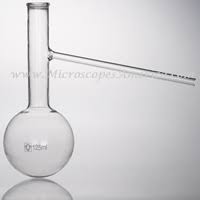Yes, we used variations on the Laboratory Glass Distillation Flask.

And there was a mantel top and bottom

Pyrex has a low coefficient of thermal conductivity, so the stoppered end got hot, some time burned the stopper a little, but not much.
And there was a mantel top and bottom
Pyrex has a low coefficient of thermal conductivity, so the stoppered end got hot, some time burned the stopper a little, but not much.




Comment